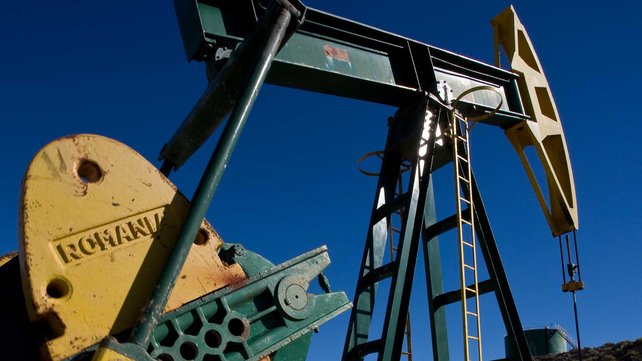…World oil prices renew downward spiral on a re-affirmed glut.
The international oil price benchmark Brent North Sea crude has dropped from its $60 per barrel level in February, 2015 to $55.06 per barrel this third week of March, 2015 as the US benchmark West Texas Intermediate (WTI) for delivery in April also shed $1.52 to stand at $43.14 a barrel.
Brent North Sea crude for May delivery lost 85 cents to stand at $55.06 in London deals. WTI had gained $1.20 on Wednesday, March 18, 2015 and Brent jumped $2.40 after the US Fed signaled it was in no hurry to raise interest rates, which sent the dollar tumbling.
A weaker US currency should make dollar-priced oil cheaper for holders of rival currencies, fueling demand. But the rally was short-lived as the fundamentals of an oversupplied market and weaker demand took hold of sentiment following the high US crude inventory report.
The US Department of Energy said stocks jumped 9.6 million barrels for the week ending March 13. Analysts said prices would remain under pressure for as long as supply was outpacing demand.
“Fundamentals have not changed and just a short-term jolt in prices from the weakening US dollar will not change that fact. Prices are still going to stay low if demand and supply does not improve,” they added, according to RTE News.
World oil prices have collapsed by about 60% since June 2014, with strong US production exacerbating elevated output by the OPEC cartel.
OPEC members meanwhile have no choice but to maintain current production levels despite falling oil prices in order to preserve their market share, Ali al-Omair, Kuwaiti’s Minister of Oil and Chairman of Kuwait Petroleum Corporation said.
“Within OPEC, we don’t have any other choice than keeping the ceiling of production as it is because we don’t want to lose our share in the market,” the minister said.
But the minister welcomed any arrangements with non-OPEC crude producers to stabilise the market.
“If there is any type of arrangements with countries outside OPEC, we will be very happy,” Omair said after signing a co-operation agreement on oil and investment with Russia.
The 12-member Organisation of Petroleum Exporting Countries, which pumps about one-third of the world’s oil, decided in November to maintain production unchanged, sending oil prices crashing.
THE IEA PERSPECTIVE
The British news agency, Reuters, reports in the meantime oil prices might have stabilized only temporarily because the global oil glut is worsening and U.S. production shows no sign of slowing, the International Energy Agency said. The West’s energy watchdog said the United States may soon run out of spare capacity to store crude, which would put additional downward pressure on prices.
That process would last at least until the second half of 2015, when growth in U.S. oil production is expected to start abating. Combined with an increase in global demand, the expected U.S. production slowdown would [then] give some support to oil prices and respite to oil producers’ group OPEC, the IEA said.
“On the face of it, the oil price appears to be stabilizing. What a precarious balance it is, however,” the Paris-based IEA said in its monthly report. “Behind the façade of stability, the rebalancing triggered by the price collapse has yet to run its course, and it might be overly optimistic to expect it to proceed smoothly.”
The IEA said steep drops in the U.S. rig count have been a key driver of the recent price rebound, which saw Brent crude rising to $60 per barrel after falling as low as $46 in January from last year’s peaks of $115.
“Yet U.S. supply so far shows precious little sign of slowing down. Quite to the contrary, it continues to defy expectations,” the IEA said.
In February, non-OPEC production [was] estimated to have risen by about 270,000 barrels per day (bpd) on a month-on-month basis to 57.3 million bpd, led by higher output in North America. Global supply rose by 1.3 million bpd year-on-year to an estimated 94 million bpd in February, led by a 1.4-million-bpd gain for non-OPEC producers.
U.S. crude inventories soared due to output growth and plunging crude refinery throughput, with seasonal and unplanned refinery outages, weak margins and high gasoline stock builds. At last count, U.S. crude stocks stood at a record 468 million barrels, the IEA said.
“U.S. stocks may soon test storage capacity limits. That would inevitably lead to renewed price weakness, which in turn could trigger the supply cuts that have so far remained elusive,” the IEA said.
“While the U.S. supply response to lower prices might take longer to kick in than expected, it might also prove more abrupt,” it said, adding that growth would abate in the second half of 2015.
The IEA’s conclusions will disappoint OPEC, which kept its output steady at the group’s last meeting in November to protect market share and stifle U.S. oil output growth.
In the second quarter of 2015, when demand is at its weakest due to global refinery maintenance, the need for OPEC crude will be 28.5 million bpd, the IEA said – compared to the group’s current output of 30.22 million bpd in February.
TENTATIVE SIGNS OF RECOVERY
The IEA raised its demand forecast for the second half of 2015, which in turn led to a higher call on OPEC crude of 30.3 million bpd in the same period – closer to the group’s real production levels and the official target of 30 million bpd.
Having bottomed in the second quarter of 2014, global oil demand growth has since steadily risen, with year-on-year gains estimated at 1.0 million bpd for the first quarter of 2015, the IEA said.
The forecast of demand growth for 2015 as a whole has been raised by 75,000 bpd to 1.0 million bpd versus the last report and versus the 680,000 bpd growth seen in 2014, bringing global demand this year to an average of 93.5 million bpd.
“Tentative signs of a demand recovery have emerged with the turn of the year, with a heavy emphasis reserved for the word ‘tentative’,” the IEA said.
In other bullish factors – beyond political instability in certain producing countries such as Iraq and Libya – refined product markets have proved unexpectedly strong, the IEA said.
“Not only have product prices lagged those of crude during the selloff – as is common in a downturn – but they have raced ahead of them in the rebound, keeping refining margins remarkably firm, and supporting unexpectedly strong throughputs in once-depressed refining centers such as Europe and OECD Asia,” the IEA said.
“Product demand has shown signs of life, with even European demand emerging from a secular decline to show strong growth of 3.2 percent in December and 0.9 percent in January”.





